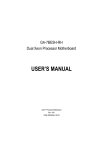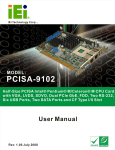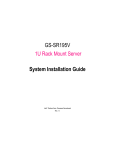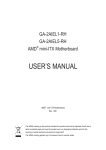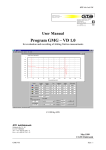Download User`s Manual
Transcript
GA-9ILDTH Dual XeonTM (Nocona) Processor Motherboard User’s Manual Dual XeonTM (Nocona)Processor Motherboard Rev. 1001 12ME-9ILDTH-1001 English GA-9ILDTH Motherboard Table of Content Item Checklist ........................................................................................ 4 WARNING!.............................................................................................. 4 Chapter 1 Introduction ............................................................................ 5 Features Summary ...................................................................................... 5 GA-9ILDTH Motherboard Layout ................................................................ 7 Chapter 2 Hardware Installation Process ............................................... 9 Step 1: Install the Central Processing Unit (CPU)..................................... 10 Step 1-2:CPU Heat Sink Installation ............................................................................... 11 Step 2: Install memory modules ................................................................ 13 2-1: DDR DIMM Slot Population ..................................................................................... 14 Step 3: Install expansion cards ................................................................. 15 Step 4: Connect ribbon cables, cabinet wires, and power supply ........... 16 Step 4-1 : I/O Back Panel Introduction .......................................................................... 16 Step 4-2 :Connectors Introduction .................................................................................. 18 Step 4-3 : Jumper Setting Introduction ........................................................................... 27 Chapter 3 BIOS Setup .......................................................................... 31 Main ........................................................................................................... 33 Advanced ................................................................................................... 36 PCI Configuration ............................................................................................................. 37 Advanced Chipset Control ............................................................................................. 39 Advanced Processor Option .......................................................................................... 41 Peripheral Configuration .................................................................................................. 43 Hardware Monitor ............................................................................................................ 46 Security ...................................................................................................... 49 Server ......................................................................................................... 51 Console Redirection ........................................................................................................ 51 Boot ............................................................................................................ 54 Exit ............................................................................................................. 55 2 Chapter 4 Technical Reference ............................................................ 58 Block Diagram ........................................................................................... 58 Chapter 5 Driver Installation .................................................................. 59 A. Intel Chipset Software Installation Utility ................................................................... 59 B. Broadcom 5721 Lan Software Installation Utility ..................................................... 61 C. Broadcom Management Applications Installation .................................................... 63 D. Adapetc 7902 Driver Installation ................................................................................ 65 Chapter 6 Appendix .............................................................................. 66 Acronyms ....................................................................................................................... 66 3 English Table of Content English GA-9ILDTH Motherboard Item Checklist The GA-9ILDTH motherboard I/O Shield x1 SCSI cable x 1 IDE to SATA HDD Power cable x 2 PATA ( 1 cables) & FDD cable set x 1 Retention Module x 2 CD for motherboard driver & utility GA-9ILDTH user’s manual COM2 cable x 1 WARNING! Computer motherboards and expansion cards contain very delicate Integrated Circuit (IC) chips. To protect them against damage from static electricity, you should follow some precautions whenever you work on your computer. 1. Unplug your computer when working on the inside. 2. Use a grounded wrist strap before handling computer components. If you do not have one, touch both of your hands to a safely grounded object or to a metal object, such as the power supply case. Hold components by the edges and try not touch the IC chips, leads or connectors, or other components. Place components on a grounded antistatic pad or on the bag that came with the components whenever the components are separated from the system. Ensure that the ATX power supply is switched off before you plug in or remove the ATX 3. 4. 5. power connector on the motherboard. Installing the motherboard to the chassis… If the motherboard has mounting holes, but they don’t line up with the holes on the base and there are no slots to attach the spacers, do not become alarmed you can still attach the spacers to the mounting holes. Just cut the bottom portion of the spacers (the spacer may be a little hard to cut off, so be careful of your hands). In this way you can still attach the motherboard to the base without worrying about short circuits. Sometimes you may need to use the plastic springs to isolate the screw from the motherboard PCB surface, because the circuit wire may be near by the hole. Be careful, don’t let the screw contact any printed circuit write or parts on the PCB that are near the fixing hole, otherwise it may damage the board or cause board malfunctioning. 4 Introduction Chapter 1 Introduction Features Summary Form Factor Motherboard 30.5cm x 33cm Extend ATX size form factor, 8 layers PCB. GA-9ILDTH Motherboard: CPU Dual socket 604 for Intel® Xeon(Nocona) processor support 4.0 GB and upper Intel® Xeon (Nocona) CPUs supports 800 MHz FSB Chipset 2nd cache depend on CPU Intel® E7520 Chipset Intel® 6300ESB Intel® 6700 PXH Memory 6 x 240-pin DDRII DIMM sockets Supports 8 ECC Registered DIMM DDRII 400 Supports up to 16GB DRAM (Max) Supports only 1.8V DDRII DIMM I/O Control Slots IT8712 F IX 2 PCI-X slot support 64/66MHz 2 PCI-X slot supports 64/133MHz (3.3V) 1 PCI-E slot by 8 x 1 On-Board IDE 1 PCI slot supports 32/33MHz (3.3V) 2 IDE bus master (ATA100) IDE ports for up to 2 ATAPI devices On-Board Peripherals 1 Floppy port supports 1 FDD with 360K, 720K,1.2M, 1.44M and 2.88M bytes. 1 Parallel port supports Normal/EPP/ECP mode 1 Serial port (COM) 4 x USB 2.0 1 x VGA port 2 x RJ45 LAN port Hardware Monitor CPU/Power/System Fan Revolution Detect CPU shutdown when overheat System Voltage Detect 5 English GA-9ILDTH Motherboard SCSI Controller Adaptec® AIC-7902W chipset supports PCI-X dual ultra 320 SCSI channels Mirroring supports automatic background rebuilds Supports RAID 0 ,1, 10 Supports HOST RAID Mirroring supports automatic background rebuilds Features LBA and Extended Interrupt 13 drive translation in On-Board SATA controller onboard BIOS Intel® 6300ESB chipset supports dual SATA channels On-Board LAN Dual Broadcom® BCM5721 PCI-E GbE On-Board VGA ATI® Rage-XL controller On-Board USB 2.0 Built in 6300ESB Chipset PS/2 Connector PS/2 Keyboard interface and PS/2 Mouse interace BIOS Lincensed Phoenix® on 8MB Flash ROM Supports multi boot function User setting for hardware monitoring Additional Features DMI 2.0 compliant PS/2 Keyboard power on by password PS/2 Mouse power on STD (Suspend-To-Disk) Wake on LAN (WOL) AC Recovery Poly fuse for keyboard over-current protection 6 Hardware Installation Process GA-9ILDTH Motherboard Layout 15 W X 16 17 18 19 20 2 P I G 4 H Q H 7 6 5 3 4 2 1 Y 8 22 9 10 11 12 C T 1 13 14 V 24 E O D R J K S 21 B F L A U Z M 23 N 7 English GA-9ILDTH Motherboard A. B. C. D. E. F. G. H. I. J. K. L. M. N. O. P. Q. R. CPU0 (Install First) CPU1 Intel E7520 Intel 6700 PXH Intel 6300ESB Adaptec 7902W ATI Rage_XL Intel 82546GB ITE IT8712F-A IDE1 IDE2 FDD1 (Floppy Connector) SCSI1 (SCSI connector) SCSI2 (SCSI connector) USB2 F_Panel1 (Front Panel) COM2 SATA1 (SATA Connector) 1. 2. 3. 4. 5. 6. 7. 8. 9. 10. 11. 12. 13. 14. 15. 16. 17. 18. PCI-E (Supports PCI Express x8) PCI-X_2 (Supports 64bit//133MHz) PCI-X_3 (Supports 64bit//133MHz) PCI-X_4 (Supports 64bit//66MHz) PCI-X_5 (Supports 64bit//66MHz) PCI_6 (Supports 32bit//33MHz) DDRIIA1 DDRIIB1 DDRIIA2 DDRIIB2 DDRIIA3 DDRIIB3 DDRIIA4 DDRIIB4 RJ45 LAN Port VGA Port Parallel Port COM Port S. SATA2 (SATA Connector) 19. USB Connectors T. U. V. W. X. Y. WOL (Wake O Lan) CPU_Fan0 CPU_Fan1 J2 (System Fan) J3 (System Fan) J4 (System Fan) 20. 21. 22. 23. 24. KB_MS (Keyboard & Mouse) BAT1 (Battery) ATX1 (SSI power connector) ATX3 (SSI power connector) ATX2 (SSI power connector) Z. J11 (System Fan) 8 Hardware Installation Process Chapter 2 Hardware Installation Process To set up your computer, you must complete the following steps: Step 1- Install the Central Processing Unit (CPU) Step 2- Install memory modules Step 3- Install expansion cards Step 4- Connect ribbon cables, cabinet wires, and power supply Step 2 Step3 2 4 Step 4 1 Step4 Step4 Step1 9 English GA-9ILDTH Motherboard Step 1: Install the Central Processing Unit (CPU) Before installing the processor , adhere to the following warning: If you do not match the CPU socket Pin 1 and CPU cut edge well, it will cause improper installation. Please change the insert orientation. Please make sure the CPU type is supported by the motherboard. Pin1 indicator 1. Angling the rod to 65-degree maybe feel a 2. CPU Top View kind of tight , and then continue pull the rod to 90-degree when a noise “cough” made. Pin1 indicator 3. Locate Pin 1 in the socket and look for a (golden) cut edge on the CPU 4. Press down the CPU socket lever and finish CPU installation. upper corner. Then insert the CPU into the socket. 10 Hardware Installation Process Step 1-2:CPU Heat Sink Installation Before installing the CPU Heat Sink , adhere to the following warning: 1.Please use Intel approved cooling fan. 2.We recommend you to apply the thermal tape to provide better heat conduction between your CPU and heatsink. (The CPU cooling fan might stick to the CPU due to the hardening of the thermal paste. During this condition if you try to remove the cooling fan, you might pull the processor out of the CPU socket alone with the cooling fan, and might damage the processor. To avoid this from happening, we suggest you to either use thermal tape instead of thermal paste, or remove the cooling fan with extreme caution.) 3.Make sure the CPU fan power cable is plugged in to the CPU fan connector, this completes the installation. Please refer to CPU heat sink user's manual for more detail installation procedure. 1. Heat sink installation kit. 2. Turn the mother bord to the backside. Lock the retention module on the mother board Make sure the position of the 4 holes on the retention module match exactly the position on the motherboard. 11 English GA-9ILDTH Motherboard 3. Fasten the heatsink supporting-base onto the 4. Make sure the CPU fan is plugged to the CPU fan connector, than install complete. CPU socket on the mainboard. 12 Hardware Installation Process Step 2: Install memory modules Before installing the processor and heatsink, adhere to the following warning: When DIMM LED is ON, do not install/remove DIMM from socket. Please note that the DIMM module can only fit in one direction due to the one notches. Wrong orientation will cause improper installation. Please change the insert orientation. The motherboard has 8 dual inline memory module (DIMM) sockets. The BIOS will automatically detects memory type and size. To install the memory module, just push it vertically into the DIMM socket .The DIMM module can only fit in one direction due to the notch. Memory size can vary between sockets. Notch DDR Table 2-1: DIMM-per Channel Implementation Single Rank DIMMS Dual Rank DIMMS MCH Fill Second Fill First Fill Fourth Fill Third D I M M D I M M D I M M D I M M D I M M D I M M D I M M D I M M A1 B1 A2 B2 A3 B3 A4 B4 13 English GA-9ILDTH Motherboard 2-1: DDR DIMM Slot Population Table 1. Supported DIMM Module Type Technology 256MB 512MB 1GB Organization 8MB x 8 x 4 bks 16MB x 4 x 4bks 16MB x 8 x 4bks 32MB x 4 x 4bks 32MB x 8 x 4bks 64MB x 4 x 4bks SDRAM Chips/DIMM 8 16 8 16 8 16 Table 2. DIMM Placement DDR2-400 DIMM Configuration 1 Single Rank 1 Dual Rank 2 Single Rank 1 Dual Rank, 1 Single Rank 2 Dual Rank 3 Single Rank 1 Dual Rank, 2 Single Rank DIMM1 Empty Empty Empty Empty Empty Single Rank Single Rank DIMM2 Empty Empty Single Rank Single Rank Dual Rank Single Rank Single Rank DIMM3 Single Rank Dual Rank Single Rank Dual Rank Dual Rank Single Rank Dual Rank Installation Step: 1. Unlock a DIMM socket by pressing the retaining clips outwards. 2. Aling a DIMM on the socket such that the moyches on the DIMM exactly match the notches in the socket. Please note that DIMM must be populated in order starting at the nearest slot from the ATX power. 3. Firmly insert the DIMMinto the socket until the retaining clips snap back in place. 4. When installing the DIMM into the DIMM socket, we recommend to populate one DIMM in Channel A module and one in Channel B module for best performance. Please note that each logical DIMM must be madeof two identical DIMMs having the same device size on each and the same DIMM size. 5. Reverse the installation steps when you wish to remove the DIMM module. 14 English GA-9ILDTH Motherboard Step 3: Install expansion cards 1. Read the related expansion card’s instruction document before install the expansion card into the computer. 2. Remove your server’s chassis cover, necessary screws and slot bracket from the computer. 3. Press the expansion card firmly into expansion slot in motherboard. 4. Be sure the metal contacts on the card are indeed seated in the slot. 5. Replace the screw to secure the slot bracket of the expansion card. 6. Replace your computer’s chassis cover. 7. Power on the computer, if necessary, setup BIOS utility of expansion card from BIOS. 8. Install related driver from the operating system. 15 Hardware Installation Process Step 4: Connect ribbon cables, cabinet wires, and power supply Step 4-1 : I/O Back Panel Introduction 4 2 PS/2 Keyboard and PS/2 Mouse Connector PS/2 Mouse Connector (6 pin Female) This connector supports standard PS/2 keyboard and PS/2 mouse. PS/2 Keyboard Connector (6 pin Female) 16 Hardware Installation Process USB Connectors Before you connect your device(s) into USB connector(s), please make sure your device(s) such as USB keyboard, mouse, scanner, zip, speaker..etc. Have a standard USB interface. Also make sure your OS supports USB controller. USB1 If your OS does not support USB controller, please contact OS vendor for possible patch or driver upgrade. For more information please contact your OS or device(s) vendors. Parallel Port / Serial Port / VGA Port (LPT/COMA/VGA) Parallel Port This connector supports 1 standard COM port (25 pin Female) and 1 Parallel port. Device like printer can be connected to Parallel port ; mouse and modem etc can be connected to Serial port. COMA VGA Port Serial Ports (9 pin Male) (15 pin Female) LAN Connecotrs LAN Port Status Description LAN Yellow LED On Green LED On GIGALAN connected GIGALAN at Speed 10/100MB Green LED Blinking Data Transfer 17 English GA-9ILDTH Motherboard Step 4-2 :Connectors Introduction S Q R 2 N 4 M A C K B 1 L G H U D F T E A) B) C) D) E) F) G) H) I) J) K) I J P O ATX1 ATX3 ATX2 IDE1 IDE2 FDD1 SATA1 SATA2 SCSI1 SCSI2 WOL L) M) N) O) P) Q) R) S) T) U) 18 USB2 COM2 F_Panel1 CPU_FAN0 CPU_FAN1 J2 (System Fan) J3 (System Fan) J4 (System Fan) J11 (System Fan) BAT1 (Battery) Connector Introduction A) ATX 1 (ATX Power Connector) 1 13 2 4 1 12 AC power cord should only be connected to your power supply unit after ATX power cable and other related devices are firmly connected to the mainboard. 24 PIN No. Definition 1 +3.3V 2 3 +3.3V GND 4 5 +5V GND 6 7 +5V GND 8 9 POK 5VSB 10 11 +12V +12V 12 13 +3.3V +3.3V 14 15 -12V GND 16 17 PSON GND 18 19 GND GND 20 21 -5V +5V 22 23 +5V +5V 24 GND B ) ATX3 (ATX Power Connector) 2 4 1 1 19 Pin No. 1 2 3 4 5 6 7 8 Definition GND GND GND GND P12V_CPU1 P12V_CPU1 P12V_CPU0 P12V_CPU0 English GA-9ILDTH Motherboard C ) ATX2 (ATX Power Connector) This connector (ATX _12V) suppliesthe CPU operation voltage (Vcore). If this " ATX_ 12V connector" is not connected, system cannot boot. 2 4 1 3 2 4 Pin No. 1 2 3 4 Definition GND GND +12V +12V 1 D / E) IDE1 / IDE2 Connector(Primary/Secondary] Please connect first harddisk to IDE1 and connect CDROM to IDE2. The red stripe of the ribbon cable must be the same side with the Pin1. 2 4 39 1 40 2 1 IDE2 IDE1 20 Connector Introduction F) FDD1 (Floppy Connector) Please connect the floppy drive ribbon cables to FDD. It supports 360K,720K,1.2M,1.44M and 2.88Mbytes floppy disk types. The red stripe of the ribbon cable must be the same side with the Pin1. 1 2 2 4 1 33 34 G / H) SATA1/SATA2 (Serial ATA Connectors) You can connect the Serial ATA device to this connector, it provides you high speed transfer rates (150MB/sec). 2 4 1 7 1 SATA1 SATA2 21 Pin No. 1 2 3 4 5 6 7 Definition GND TXP TXN GND RXN RXP GND English GA-9ILDTH Motherboard I / J) SCSI1 / SCSI2 (SCSI Connector) 2 4 1 SCSI 1 SCSI 2 K) WOL (Wake on LAN) This connector allows the remove servers to manage the system that installed this mainboard via your network adapter which also supports WOL. 2 4 1 1 22 Pin No. 1 2 3 Definition +5V SB GND Signal English GA-9ILDTH Motherboard L) USB2 (Front USB Connector ) Be careful with the polarity of the front USB connector. Check the pin assignment while you connect the front USB cable. Please contact your nearest dealer for optional front USB cable. 2 4 1 2 9 10 1 Pin No. 1 2 3 4 5 6 7 8 9 10 Definition Power GND USB DXNC USB DX+ USB Dy+ NC USB DyGND Power M ) COM2 2 1 4 1 23 Pin No. 1 2 3 4 5 6 7 8 9 10 Definition NDCDA2NDSRA2NSINA2 NRTS42NSOUTA2NCTSA2NDTRA2NRIA2GND NC Connector Introduction N ) F_Panel1 (2X13 Pins Front Panel connector) 2 4 1 2 Please connect the power LED, PC speaker, reset switch and power switch of your chassis front panel to the F_PANEL connector according to 1 the pin assignment above. 12 24 Pin No 1 2 3 4 5 6 7 8 9 10 11 12 13 14 15 16 17 18 19 20 21 22 23 24 Signal Name Description PWRLED+ P5V_STBY Key ID_LED+ PWRLEDID_LEDHD_LED+ NC HD_LEDNC PWB+ LAN1_ACT# PWB+_GND LAN1_LINK_LED RST_BTN SENSOR_SDA RST_BTN_GND SENSOR_SCL FP_ID_SW+ INTRUDER FP_ID_SWLAN2_ACT# NMI_SWLAN2_LINK_LED Power LED Signal anode (+) Standby power button Pin Removed ID LED Signal anode (+) Power LED Signal cathode(-) ID LED Signal cathode(-) Hard Disk LED anode (+) No Connect Hard Disk LED cathode(-) No Connect Soft Power connector anode (+) LAN1 access LED Signal Ground LAN1 linked LED Signal Reset Button Sensor SM Bus Data Button Reset Button Ground Sensor SM Bus Clock Button ID Switch LED Signal anode (+) Case Open Intrusion ID Switch LED Signal cathode(-) LAN1 access LED Signal NMI Switch cathode(-) LAN2 linked LED Signal 24 English GA-9ILDTH Motherboard O / P ) CPU_FAN0 /1 (CPU Fan Connector) Please note, a proper installation of the CPU cooler is essential to prevent the CPU from running under abnormal condition or damaged by overheating.The CPU fan connector supports Max. current up to 1A . 2 4 CPU FAN 0 1 1 Pin No. 1 2 3 4 1 CPU FAN 1 CPU FAN 0 CPU FAN 1 25 Definition GND 12V Sense Control Connector Introduction Q / R / S ) J2 / 3 / 4 (System Fan Connector) This connector allows you to link with the cooling fan on the system case to lower the system temperature. These connectors are for system use only. 2 4 1 SYS FAN 1 1 SYS FAN Pin No. 1 2 3 Definition GND 12V Sense Pin No. 1 2 3 Definition GND 12V Sense U ) BT1 (Battery) 2 4 CAUTION Danger of explosion if battery is incorrectly replaced. 1 Replace only with the same or equivalent type recommended by the manufacturer. Dispose of used batteries according to the manufacturer’s instructions. If you want to erase CMOS... 1.Turn OFF the computer and unplug the power cord. 2.Remove the battery, wait for 30 second. 3.Re-install the battery. 4.Plug the power cord and turn ON the computer. 26 English GA-9ILDTH Motherboard Step 4-3 : Jumper Setting Introduction 4 2 4 1 1 3 6 5 1) J8 2 ) JP 1 3 ) JP 3 4 ) JP2 5 ) JP4 6 ) CLR_CMOS 27 2 Jumper Setting 1) J8 (FWH Write Protect Setting Jumper) 2 4 1-2 close: Top Block Lock (Default) 3-4 close: 2-8 Block Lock Open: Enable CMOS Write Protection 1 Function 2 / 3) JP1/JP3 (USB Wake Up Function) 2 JP1 4 1 1-2 close: Enable USB wake-up function 1 1 1 1 JP3 28 2-3 close: Normal (Default) English GA-9ILDTH Motherboard 4) JP2 (Onboard VGA Enable/Disable Function) 2 4 1 1 1-2 close: Enable VGA function (Default) 2-3 close: Disable VGA function 1 5) JP4 (On board SCSI Enable/Disable Function) 2 4 1 1-2 close: Enable SCSI function (Default) 1 1 29 2-3 close: Disable SCSI function Jumper Setting 6) CLR_CMOS (Clear CMOS Function) You may clear the CMOS data to its default values by this jumper. Default value doesn’t include the “Shunter” to prevent from improper use this jumper. To clear CMOS, temporarily short 1-2 pin. 2 4 1 30 1 1-2 close: Clear CMOS 1 2-3 close: Normal (Default) BIOS Setup Chapter 3 BIOS Setup BIOS Setup is an overview of the BIOS Setup Program. The program that allows users to modify the basic system configuration. This type of information is stored in battery-backed CMOS RAM so that it retains the Setup information when the power is turned off. ENTERINGSETUP Power ON the computer and press <F2> immediately will allow you to enter Setup. CONTROLKEYS <Ç> Move to previous item <È> Move to next item <Å> Move to the item in the left hand <Æ> Move to the item in the right hand <Esc> Main Menu - Quit and not save changes into CMOS Status Page Setup Menu and Option Page Setup Menu - Exit current page and return to Main Menu <+/PgUp> Increase the numeric value or make changes <-/PgDn> Decrease the numeric value or make changes <F1> General help, only for Status Page Setup Menu and Option Page Setup Menu <F2> Reserved <F3> Reserved <F4> Reserved <F6> Reserved <F7> Reserved <F8> Reserved <F9> Load the Optimized Defaults <F10> Save all the CMOS changes, only for Main Menu 31 GA-9ILDTH Motherboard GETTINGHELP Main Menu The on-line description of the highlighted setup function is displayed at the bottom of the screen. Status Page Setup Menu / Option Page Setup Menu Press F1 to pop up a small help window that describes the appropriate keys to use and the possible selections for the highlighted item. To exit the Help Window press <Esc>. z Main z Advanced This setup page includes all the items in standard compatible BIOS. This setup page includes all the items of AMI special enhanced features. (ex: Auto detect fan and temperature status, automatically configure hard disk parameters.) z Security Change, set, or disable password. It allows you to limit access the system and setup. z Server z Boot Server additional features enabled/disabled setup menus. This setup page include all the items of first boot function features. z Exit There are five optionsin this selection: Exit Saving Changes, Exit Discarding Changes, Load Optimal Defaults, Load Failsafe Defaults, and Discard Changes. 32 BIOS Setup Main Once you enter Phoenix BIOS Setup Utility, the Main Menu (Figure 1) will appear on the screen. Use arrow keys to select among the items and press <Enter> to accept or enter the sub-menu. PhoenixBIOS Setup Utility Main Advanced Security Server System Time: [00:13:12] System Date: [01/01/2005] Lagecy Disktte A [1.44MB 31/2] IDE Channel 0 Master [80026MB] IDE Channel 0 Slave [None] IDE Channel 1 Master [CD-ROM] IDE Channel 1 Slave [None] S-ATA0 [None] S-ATA1 [None] Boot Exit Item Specific Help System Information F1: Help Esc: Exit KL: Select Item IJ: Select Menu + -: Change Values F5: Setup Defaults Enter: Select Sub-Menu F10: Save&Exit Figure 1: Main System Time The time is calculated based on the 24-hour military time clock. Set the System Time (HH:MM:SS) System Date Set the System Date. Note that the “Day” automatically changed after you set the date. (Weekend: DD: MM: YY) (YY: 1099~2099) 33 GA-9ILDTH Motherboard Legacy Diskette A This category identifies the type of floppy disk drive A that has been installed in the computer. Disabled Disable this device. 360KB, 5 in. 3 1/2 inch AT-type high-density drive; 360K byte capacity 1.2MB, 31/2 in. 3 1/2 inch AT-type high-density drive; 1.2M byte capacity 720K, 31/2 in. 31/2 inch double-sided drive; 720K byte capacity 1.44M, 3 1/2 in. 3 1/2 inch double-sided drive; 1.44M byte capacity. 2.88M, 3 3 1/2 inch double-sided drive; 2.88M byte capacity. 1/4 1/2 in. * Note: The 1.25MB,3 1/2 reference a 1024 byte/sector Japanese media format. The 1.25MB,31/2 diskette requires 3-Mode floppy-disk drive. IDE Channel 0 Master, Slave / Channel 1 Master, Slave, Serial ATA The category identifies the types of hard disk from drive C to F that has been installed in the computer. There are two types: auto type, and manual type. Manual type is user-definable; Auto type which will automatically detect HDD type. Note that the specifications of your drive must match with the drive table. The hard disk will not work properly if you enter improper information for this category. If you select User Type, related information will be asked to enter to the following items. Enter the information directly from the keyboard and press <Enter>. Such information should be provided in the documentation form your hard disk vendor or the system manufacturer. 34 BIOS Setup TYPE 1-39: Predefined types. Users: Set parameters by User. Auto: Set parameters automatically. (Default Vaules) CD-ROM: Use for ATAPI CD-ROM drives or double click [Auto] to set all HDD parameters automatically. ATAPI Removable: Removable disk drive is installed here. Multi-Sector Transfer This field displays the information of Multi-Sector Transfer Mode. Disabled: The data transfer from and to the device occurs one sector at a time. Auto: The data transfer from and to the device occurs multiple sectors at a time if the device supports it. LBA Mode This field shows if the device type in the specific IDE channel support LBA Mode. 32-Bit I/O Enable this function to max imize the IDE data transfer rate. Transfer Mode This field shows the information of Teansfer Mode. Ultra DMA Mode This filed displays the DMA mode of the device in the specific IDE channel. System Information This category includes the information of Processor Type, Speed, Extended memory, BIOS Version, BIOS Date, System Product Name, System serial number, System version, System UUID, Main Board ID, and Main Board Serial number. 35 GA-9ILDTH Motherboard Advanced About This Section: Advanced With this section, allowing user to configure your system for basic operation. User can change the processor options, chipset configuration, PCI configuration and chipset control. PhoenixBIOS Setup Utility Main Advanced Security Server PCI Configuration Boot Exit Item Specific Help Advanced Chipset Control Advanced Processor Option Peripheral Configuration Hardware Monitor Reset Configuration Data [No] ClkGen Spread Spectrum [Disabled] System After AC Back [Pre-State] Extended Memory Testing [Enabled] Network Server [Enabled] F1: Help Esc: Exit KL: Select Item IJ: Select Menu + -: Change Values F5: Setup Defaults Enter: Select Sub-Menu F10: Save&Exit Figure 2: Advanced 36 BIOS Setup PCI Configuration PhoenixBIOS Setup Utility PCI Configuration Item Specific Help Embedded Vedio Controller Embedded SCSI Controller Embedded NIC Controller F1: Help Esc: Exit KL: Select Item IJ: Select Menu + -: Change Values F5: Setup Defaults Enter: Select Sub-Menu F10: Save&Exit Figure 2-1: PCI Configuration Embedded Video Controller Onboard VGA Control Enabled Enable onboard VGA device. (Default value) Disabled Disable this function. Embedded SCSI Controller Onboard SCSI Controller Enabled Enable onboard SCSI device. (Default value) Disabled Disable this function. Option ROM Scan Enabled Enableing this item to initialize device expansion ROM. (Defualt value) Disabled Disable this function. 37 GA-9ILDTH Motherboard EmbeddedNIC Onboard LAN Control Enabled Enable onboard LAN device. (Default value) Disabled Disable this function. Option ROM Scan Enabled Enableing this item to initialize device expansion ROM. Disabled Disable this function. (Defualt value) 38 BIOS Setup Advanced Chipset Control PhoenixBIOS Setup Utility Advanced Chipset Control Item Specific Help USB Controller Legacy USB Support [Enabled] [Disabled] Force Compliance Mode [Enabled] PCI-E port C Device 6 [Enabled] 4GB PCI Hole Granularity [128MB] Data Parity Error Recovery [Enabled] Wake On LAN [Enabled] F1: Help Esc: Exit KL: Select Item IJ: Select Menu Item Specific Help + -: Change Values F5: Setup Defaults Enter: Select Sub-Menu F10: Save&Exit Figure 2-2: Advanced Chipset Control USB Controller This item allows users to enable or disable the USB device by setting item to the desired value. Enabled Enable USB controller. (Default value) Options Disbale this function. Legacy USB Support This option allows user to function support for legacy USB. Enabled Enables support for legacy USB. Disabled Disables support for legacy USB. (Default Value) 39 GA-9ILDTH Motherboard Force Compliance Mode This option allows user to function PCI-E Compliance mode by setting item to desired value. Enabled Enables PCI-E Force Compliance mode. (Default Value) Disabled Disables this function. 4GB PCI Hole Granularity By selecting the granularity of PCI hole for PCI resource, when MTRRs are not enough, we may use this option to reduce the MTRR occupation. Options 128MB, 256MB. Default value is set to 128MB. Data Parity Error Recovery Enabled Enable data parity error recovery function. (Default vaules) Disabled Disable this function. Wake On LAN This option allow user to determine the action of the system when a LAN wake up occurs. Enabled Enable Wake On LAN. (Default value) Disabled Disable this function. Note: This item must enabled if you’re running under Windows operating system. 40 BIOS Setup Advanced Processor Option PhoenixBIOS Setup Utility Advanced Processor Option Item Specific Help Hyper Threading Technology [Enabled] Echo TPR [Disabled] Machine Checking [Disabled] Adjacent Cache Line Prefetch [Enabled] Set Max Ext CPUID=3 [Enabled] F1: Help Esc: Exit KL: Select Item IJ: Select Menu + -: Change Values F5: Setup Defaults Enter: Select Sub-Menu F10: Save&Exit Figure 2-3: Advanced Processor Option Hyper Threading Technology Enabled Enables Hyper-Threading Technology Feature when using Windows XP and Linux 2.4x operating systems that are optimized for HyperThreading technology. (Default value) Disabled Disables Hyper-Threading Technology when using other operating systems. Echo TPR When this item is enabled, xTPR messages are transmitted on the system bus to the central agent. When set to disabled, it will disable sending xTPR messages on the system bus. Enabled Enable Echo TPR function. Disabled Disable this function. (Default value) Machine Checking Enabled Enable Machine Checking. Disabled Disable this function. (Default value) 41 GA-9ILDTH Motherboard Adjacent Cache Line Prefetch Enabled Processor will fetch both cache lines when it requires data that is not currently inits cache. (Defualt value) Disabled Processor will only fetch the cache line that contains the data currently required by the processor. Set Max Ext CPUID = 3 Set MAX CPUID extended function value to 3. Enabled Enable Set Max Ext CPUID = 3 function. Disabled Disable this function. (Default value) 42 BIOS Setup Peripheral Configuration PhoenixBIOS Setup Utility Peripheral Configuration Serial Port A Item Specific Help [Enabled] Base I/O address/IRQ Serial Port B [3F8/IRQ4] [Enabled] Base I/O address/IRQ Parallel Port [2F8/IRQ3] [Enabled] Mode [Bi-directional] Base I/O addreee [378] DMA Channel [DMA3] Floppy disk connector [Disabld] Floppy check [Disabld] Parallel ATA [Both] Serial ATA [Enabled] Native Mode Operation [Auto] F1: Help Esc: Exit KL: Select Item IJ: Select Menu + -: Change Values F5: Setup Defaults Enter: Select Sub-Menu F10: Save&Exit Figure 2-4: Peripheral Configuration Serial Port A This allows users to configure serial prot A by using this option. Disabled Disable the configuration. Enabled Enable the configuration (Default value) Base I/O Address/IRQ 3F8/IRQ4 Set IO address to 3F8. (Default value) 2F8/IRQ3 Set IO address to 2F8. 3E8/IRQ4 Set IO address to 3E8. 2E8/IRQ3 Set IO address to 2E8. 43 GA-9ILDTH Motherboard Serial Port B This allows users to configure serial prot B by using this option. Disabled Disable the configuration. (Default value) Enabled Enable the configuration Base I/O Address/IRQ 3F8/IRQ4 Set IO address to 3F8. 2F8/IRQ3 Set IO address to 2F8. 3E8/IRQ4 Set IO address to 3E8. (Default value) 2E8/IRQ3 Set IO address to 2E8. Parallel Port This allows users to configure parallel port by using this option. Enabled Enable the configuration. Disabled Disable the configuration. (Default value) Mode This option allows user to set Parallel Port transfer mode. EPP Using Parallel port as Enhanced Parallel Port. Bi-directional Use this setting to support bi-directional transfers on the parallel port. ECP Using Parallel port as Extended Capabilities Port. (Default value) Base I/O Address 378 Set IO address to 378 278 Set IO address to 278. DMA Channel DMA1 Select DMA1 as DMA channel. DMA3 Select DMA3 as DMA channel. (Default values) 44 BIOS Setup Floppy disk controller Enabled Enable the floppy disk controller. Disabled Disable the device. (Default value) Floppy Check Enabled Enable the device to verify floppy typer when system boot. Disabled Disable the this function. (Default value) Parallel ATA Disabled Disable the device. Both Select both Channel 0 and Channel 1 as Parallel ATA. Channel 0 Select both Channel 0 as Parallel ATA. Channel1 Select both Channel 1 as Parallel ATA. (Default value) Serial ATA Enabled Enable Serial ATA device. (Default value) Disabled Disable the Serial ATA. Native Mode Operation This option allows user to set the native mode for ATA function. Note that certain OS is not supported under Native Mode. Auto Auto detected. (Default value) Serial ATA Set Native mode to Serial ATA. Parallel ATA Set Native mode to Parallel ATA. Both Set Native mode to Parallel ATA and Serial ATA. 45 GA-9ILDTH Motherboard Hardware Monitor PhoenixBIOS Setup Utility Hardware Monitor Item Specific Help Fan Alarm [Enabled] Voltage Alarm [Enabled] Temperature Alarm [Enabled] CPU Temperature 38C/100F SDRAM Socket Temperature 33C/091F PCI Connector Temperature 33C/091F SCSI Connector Temperature 33C/091F Voltage Monitor Fan Monitor F1: Help Esc: Exit KL: Select Item IJ: Select Menu + -: Change Values F5: Setup Defaults Enter: Select Sub-Menu F10: Save&Exit Figure 2-5: Hardware Monitor Hardware Monitor Configuration All items on this menu cannot be modified in user mode. If any items requires changes, please consult your system supervisor. 46 BIOS Setup Fan Alarm Enabled Enable Fan Alarm function. (Default value) Disabled Disable this function. Voltage Alarm Enabled Enable Voltage Alarm function. (Default value) Disabled Disable this function. Temperature Alarm Enabled Enable Temperature Alarm function. (Default value) Disabled Disable this function. CPU Temperature This field only displlays the current CPU 0/1 temperature. SDRAM Socket Temperature This field only displlays the current SDRAM Socket temperature. PCI Connector Temperature This field only displlays the current PCI connector temperature. SCSI Connector Temperature This field only displlays the current SCSI connector temperature. Voltage Monitor ` Voltage: VCORE1 / VCORE2 / 3.3V / 5V / 3VSB / 1.5 VSB / +12V / VBAT / 5VSB Detect system's voltage status automatically. Fan Monitor ` Fan: CPU Fan1 / CPU Fan2 / Power Fan / System Fan1 / System Fan2 / System Fan3 Display the current CPUs, Power and System 1/2/3 FAN speed. 47 GA-9ILDTH Motherboard Reset Configuration Data Yes Clear the Extended System Configuration Data (ESCD) area. No Disable this function. (default value) Clk Gen Spread Spectrum Enabled Enable ClkGen Spread Spectrum. Disabled Disabled this function. (Default value) System After AC Back Set the mode od operation if an AC/Power loss occurs. Power On Power on system without pressing power button. Stay Off Keep the power off until the power button is pressed. Pre- State Set system to the last sate when AC power is removed. Do not power on system when AC power is back. (Default value) Extended Memory Testing Determine which type of tests will be performed extended memory. (above 1M) Enabled Enable Extended Memory Testing. (Default value) Disabled Disable this function. Network Server Enabled System will be secured at boot to prevent tampering during network operation. (Default value) Disabled Disable this function. 48 BIOS Setup Security PhoenixBIOS Setup Utility Main Advanced Security Server Supervisor Password Is: User Password Is: Clear Clear Set Supervisor Password [Enter] Set User Password [Enter] Password On Boot [Disabled] F1: Help Esc: Exit KL: Select Item IJ: Select Menu Boot Exit Item Specific Help + -: Change Values F5: Setup Defaults Enter: Select Sub-Menu F10: Save&Exit Figure 3: Security * About This Section: Security In this section, user can set either supervisor or user passwords, or both for different level of password securities. In addition, user also can set the virus protection for boot sector. Set Supervisor Password You can install and change this options for the setup menus. Type the password up to 6 characters in lengh and press <Enter>. The password typed now will clear any previously entered password from the CMOS memory. You will be asked to confirm the entered password. Type the password again and press <Enter>. You may also press <Esc> to abort the selection and not enter a specified password or press <Enter> key to disable this option. 49 GA-9ILDTH Motherboard Set User Password You can only enter but do not have the right to change the options of the setup menus. When you select this function, the following message will appear at the center of the screen to assist you in creating a password. Type the password up to 6 characters in lengh and press <Enter>. The password typed now will clear any previously entered password from the CMOS memory. You will be asked to confirm the entered password. Type the password again and press <Enter>. You may also press <Esc> to abort the selection and not enter a specified password. Password on boot Password entering will be required when system on boot. Enabled Requries entering password when system on boot. Disabled Disable this function. (Default value) 50 BIOS Setup Server PhoenixBIOS Setup Utility Main Advanced Security Server Boot Console Redirection Item Specific Help Halt On [Mid] Memory RAS Feature Control [Standard] Clear Mem. ECC Error Info. [Disabled] Fatal Err on port C [Enabled] F1: Help Esc: Exit Exit KL: Select Item IJ: Select Menu + -: Change Values F5: Setup Defaults Enter: Select Sub-Menu F10: Save&Exit Figure 4: Server Console Redirection PhoenixBIOS Setup Utility Console Redirection Item Specific Help Com Port Address Baud Rate [19.2K] Console Type [Direct] Flow Control [CTS/RTS] Continue C.R after POST [Off] F1: Help Esc: Exit KL: Select Item IJ: Select Menu + -: Change Values F5: Setup Defaults Enter: Select Sub-Menu F10: Save&Exit Figure 4-1: Console Redirection 51 GA-9ILDTH Motherboard Com Port Address If this option is set to enabled, it will use a port on the motherboard. On-board COMA Use COMA as he COM port address. On-board COMB Use COMB as he COM port address. Disabled Disable this function. (Default value) Baud Rate This option allows user to set the specified baud rate. Options 9600, 19.2K, 38.4K, 57.6K, 115.2K. Console Type This option allows user to select the specified console type. This is defined by IEEE. PC-ANSI is the standard PC-type terminal. Note that for VT100+, you must select English as your languuage. And VT-UTF8 uses unicode. Options vt100, vt100+, vt100 8bit, PC ANSI 7bit, PC-ANSI, VT-UTF8. Flow Control Enables Flow Control when EMP is dahring the same serial port as console redirection, the flow control must be set to CTS/RTS or CTS/RTS+CD depending on whether a modem is used. None Not supported. XON/OFF Software control. CTS/RTS Hardware control. (Default values) Continue C.R. after POST This option allows user to enable console redirection after O.S has loaded. On Enable console redirection after O.S has loaded. Off Disable this function. (Default value) 52 BIOS Setup Halt On The category determines whether the computer will stop if an error is detected during power up. NO Errors The system boot will not stop for any error that may be detected and you will be prompted. All Errors Whenever the BIOS detects a non-fatal error the system will be stopped. Mid The system boot will not stop for a keyboard or disk error; it will stop for all other errors. (Default value) Memory RAS Feature Control Select specified features for DIMMs. Sparing or Memory Mirroring. Standard Mirroring Select Standard as Memory RAS Feature. (Default value) Memory mirroring allows user to install two banks of redundant memory on an SMP expansion module. If the Module detects memory errors in the active memory bank, it switches to the backup memory bank if memory errors occur. Sparing This feature allows user to uses a spare online bank to provide DIMM fail-over capabilities when a pre-defined threshold of singlebit correctable errors is reached. Clear Mem. ECC Error Info Enabled Enable Clear memory ECC error information function. Disabled Disable this function. (Default value) Fatal Error on port C Enabled Enable Fatal Erre on port C. Disabled Disable this function. (Default value) 53 GA-9ILDTH Motherboard Boot PhoenixBIOS Setup Utility Main Advanced Security Server Boot + CD-ROM Drive Exit Item Specific Help + Hard Drive Removable Device F1: Help Esc: Exit KL: Select Item IJ: Select Menu + -: Change Values F5: Setup Defaults Enter: Select Sub-Menu F10: Save&Exit Figure 5: Boot * About This Section: Boot The “Boot” menu allows user to select among four possible types of boot devices listed using the up and down arrow keys. By applying <+> and <Space> key, you can promote devices and by using the <-> key, you can demote devices. Promotion or demotion of devices alerts the priority that the system uses to search for boot device on system power on. Boot Device Priority ` Removable Device / Hard Drive / CD-ROM Drive/ These three fields determines which type of device the system attempt to boot from after PhoenixBIOS Post completed. Specifies the boot sequence from the available devices. If the first device is not a bootable device, the system will seek for next available device. 54 BIOS Setup Exit PhoenixBIOS Setup Utility Main Advanced Security Server Exit Saving Changes Boot Exit Item Specific Help Exit Discarding Changes Load Settup Default Discard Changes Save Changes F1: Help Esc: Exit KL: Select Item IJ: Select Menu + -: Change Values F5: Setup Defaults Enter: Select Sub-Menu F10: Save&Exit Figure 6: Exit * About This Section: Exit Once you have changed all of the set values in the BIOS setup, you should save your chnages and exit BIOS setup program. Select “Exit” from the menu bar, to display the following sub-menu. Exit Saving Changes Exit Discarding Changes Load Settup Default Discard Change Save Changes 55 GA-9ILDTH Motherboard Exit Saving Changes This option allows user to exit system setup with saving the changes. Press <Enter> on this item to ask for the following confirmation message: Pressing ‘Y’ to store all the present setting values tha user made in this time into CMOS. Therefore, whenyou boot up your computer next time, the BIOS will re-configure your system according data in CMOS. Setup Confirmation Save configuration changes and exit now? [Yes] [No] Exit Discarding Changes This option allows user to exit system setup without changing any previous settings values in CMOS. The previous selection remain in effect. This will exit the Setup Utility and restart your compuetr when selecting this option. Load Settup Default This option allows user to load default values for all setup items. When you press <Enter> on this item, you will get a confirmation dialog box with a message as below: Setup Confirmation Load default configuratin now? [Yes] [No] 56 BIOS Setup Discard Changes This option allows user to load previos values from CMOS for all setup item. When you press <Enter> on this item, you will get a confirmation dialog box with a message as below: Setup Confirmation Load previous configuration now? [Yes] [No] Save Changes This option allows user to save setup dat ato CMOS. When you press <Enter> on this item, you will get a confirmation dialog box with a message as below: Setup Confirmation Save configuration changes now? [Yes] [No] Press [Yes] to save setup daya to CMOS. 57 GA-9ILDTH Motherboard Revision Chapter History 4 Technical Reference Block Diagram 58 Driver Installation Revision Chapter History 5 Driver Installation A. Intel Chipset Software Installation Utility Insert the driver CD-title that came with your motherboard into your CD-ROM driver, the driver CD-title will auto start and show a series of Setup Wizard dialog boxes. If not, please double click the CD-ROM device icon in "My computer", and execute the setup.exe. Installation Procedures: 1. The CD auto run program starts, Double click on “Intel Chipset Software Installation Utility” to start the chipset installation. 2. Then, a series of installation wizards appear. Follow up the wizards to install the drivers. 3.Setup completed, click “Finish” to restart your computer. Setup Wizard Auto Run windows 2. Click "Next". 1. Click "Intel Chipset Software Installation Utility" item. (2) (1) Readme Information License Aggremment 3. Click "Yes". 4. Click "Next". (3) (4) 59 GA-9ILDTH Motherboard Installation Completed 5. Installation completed, Click "Finish" to restart computer. (5) 60 Driver Installation B. Broadcom 5721 Lan Software Installation Utility Insert the driver CD-title that came with your motherboard into your CD-ROM driver, the driver CD-title will auto start and show a series of Setup Wizard dialog boxes. If not, please double click the CD-ROM device icon in "My computer", and execute the setup.exe. Installation Procedures: 1. The CD auto run program starts, Double click on “Broadcom 5721 Lan Software Installation Utility” to start the installation. 2. Select “DRIVER INSTALLER” to start installation. 3. Then, a series of installation wizards appear. Follow up the wizards to install the drivers. 4. Setup completed, click “Finish” to restart your computer. Broadcom Lan Software Auto Run windows 2. Click on “DRIVER INSTALLER”. 1. Click "Broadcom 5721 Lan Software Installation Utility" item. (2) (1) Driver Installation Wizard License Agreement 4. Select “ I accpet the terms in the license agreement” and Click "Next". 3. Click "Next". (3) (4) 61 GA-9ILDTH Motherboard Ready to instll program Installation Completed 6. Installation Wizard completed. 5. Click "Install" to start Click "Finish". installation. (5) (6) 62 Driver Installation C. Broadcom Management Applications Installation Insert the driver CD-title that came with your motherboard into your CD-ROM driver, the driver CD-title will auto start and show a series of Setup Wizard dialog boxes. If not, please double click the CD-ROM device icon in "My computer", and execute the setup.exe. Installation Procedures: 1. The CD auto run program starts, Double click on “Broadcom 5721 Lan Software Installation Utility” to start the installation. 2. Select “MANAGEMENT APPLICATIONS” to start installation. 3. Then, a series of installation wizards appear. Follow up the wizards to install the drivers. 4. Setup completed, click “Finish” to restart your computer. Broadcom Lan Software Auto Run windows 2. Click on “MANAGEMENT APPLICATIONS”. 1. Click "Broadcom 5721 Lan Software Installation Utility" item. (2) (1) InstallShield Wizard Welcome Window License Agreement 4. In the License Aggreement, select “I accpet theterms in the license aggrement” and click "Next". 3. Click “Next” to start installation. (4) (3) 63 GA-9ILDTH Motherboard CUSTOM Setup Ready to Install 5. Click on an icon in the left window to change how a feature is installed. 6. Ready to install the program. Click “Install” Click “Next”. (5) (6) CUSTOM Setup Features Control Suite BASP This feature will install Broadcom Advanced Control Suite graphical user interface. This application contains a set of utilities supporting diagnostic, monitoring, and configuration for Broadcom network adapters. This feature will install Broadcom Advanced Server Program. This NDIS intermediates driver software allow for load balancing and failover, and VLAN capabilities. SNMP This feature will install SNMP sub-agent, allowing he SNMP manager to monitor the Broadcom Network Adapters. Note that the the Microsoft SNMP Service must be running for this feature to function properly. Installaiton Wizard Completed 7. Installation completed. Click “Finish”. (7) 64 Driver Installation D. Adapetc 7902 Driver Installation Installation Procedures: 1. The CD auto run program starts, Double click on “Intel SATA Host Raid Driver”. 2. Select the folder depending on your operating system. 3. Copy all files to the floppy disk. 4. Reboot the system. 5. Insert the floppy disk and press F6 when system boot. Driver Installation Auto Run windows 2. Double click "Driver" folder. 1. Click " Adaptec 7902 Driver" item. (2) (1) Operating System Selection Copying Files 3. Select the folder referring to your operating system. 4. Copy files to floppy disk. (3) (4) 65 GA-9ILDTH Motherboard Revision Chapter History 6 Appendix Acronyms Acronyms ACPI Meaning Advanced Configuration and Power Interface APM AGP Advanced Power Management Accelerated Graphics Port AMR ACR Audio Modem Riser Advanced Communications Riser BBS BIOS BIOS Boot Specification Basic Input / Output System CPU CMOS Central Processing Unit Complementary Metal Oxide Semiconductor CRIMM CNR Continuity RIMM Communication and Networking Riser DMA DMI Direct Memory Access Desktop Management Interface DIMM DRM Dual Inline Memory Module Dual Retention Mechanism DRAM DDR Dynamic Random Access Memory Double Data Rate ECP ESCD Extended Capabilities Port Extended System Configuration Data ECC EMC Error Checking and Correcting Electromagnetic Compatibility EPP ESD Enhanced Parallel Port Electrostatic Discharge FDD FSB Floppy Disk Device Front Side Bus HDD IDE Hard Disk Device Integrated Dual Channel Enhanced IRQ Interrupt Request 66 Appexdix Acronyms I/O Meaning Input / Output IOAPIC ISA Input Output Advanced Programmable Input Controller Industry Standard Architecture LAN LBA Local Area Network Logical Block Addressing LED MHz Light Emitting Diode Megahertz MIDI MTH Musical Instrument Digital Interface Memory Translator Hub MPT NIC Memory Protocol Translator Network Interface Card OS OEM Operating System Original Equipment Manufacturer PAC POST PCI A.G.P. Controller Power-On Self Test PCI RIMM Peripheral Component Interconnect Rambus in-line Memory Module SCI SECC Special Circumstance Instructions Single Edge Contact Cartridge SRAM SMP Static Random Access Memory Symmetric Multi-Processing SMI USB System Management Interrupt Universal Serial Bus VID Voltage ID 67







































































